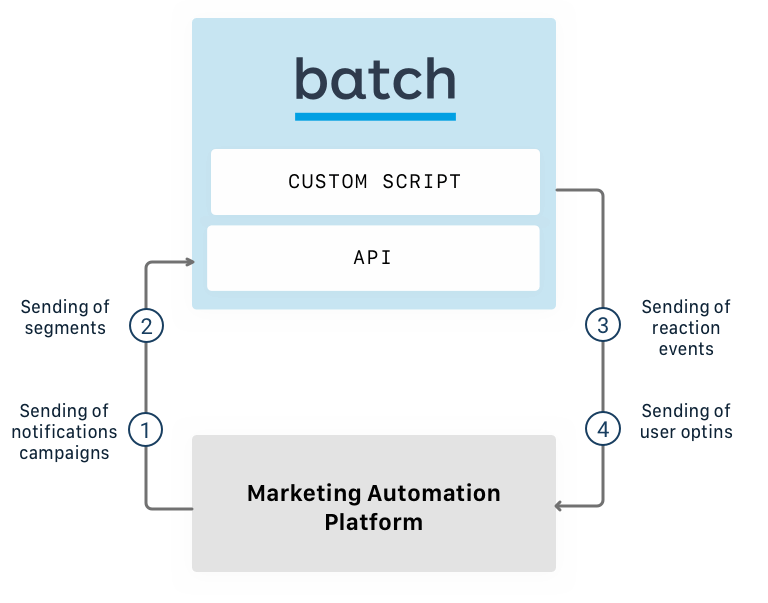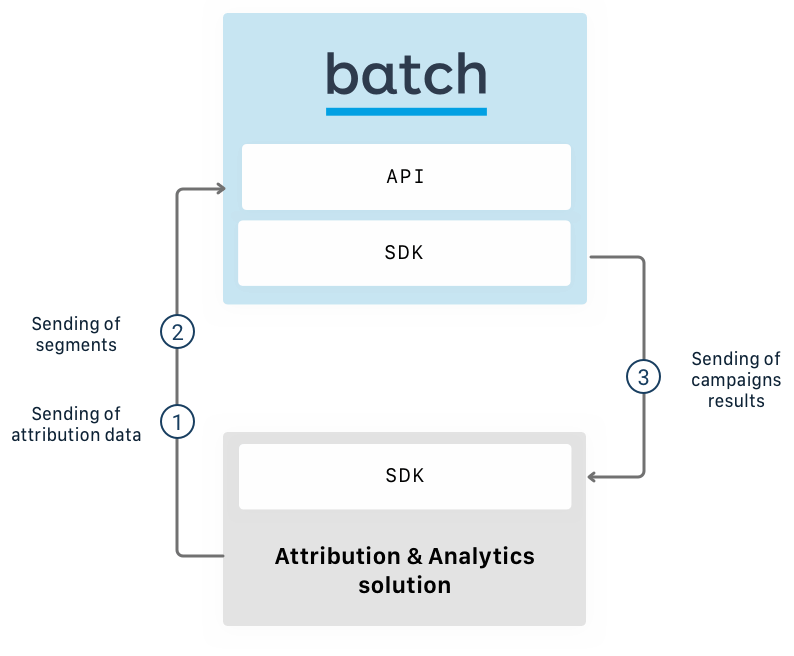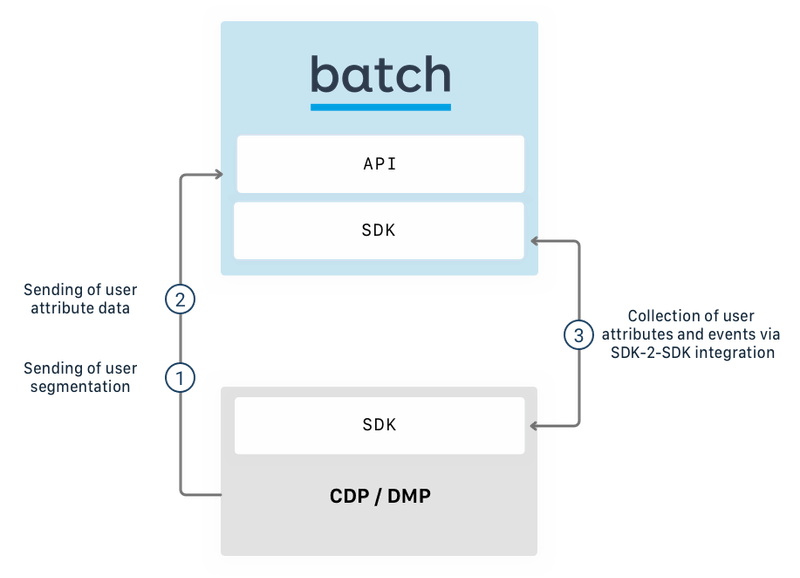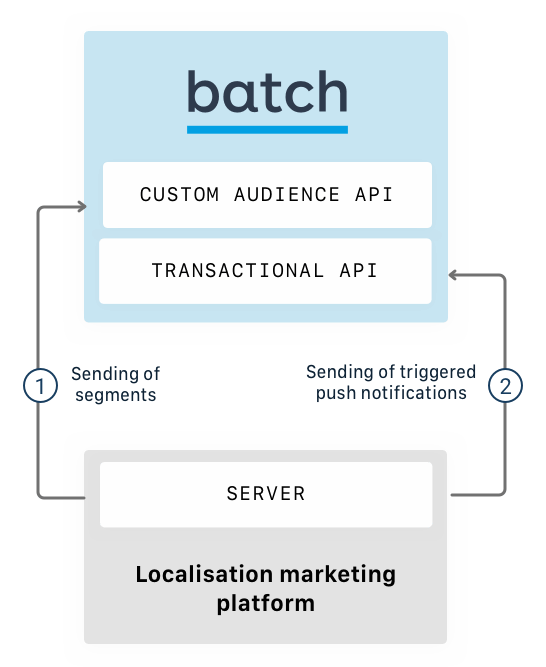Best practices & examples
Here are a few classic integration schemas that will help you conceive your integration with Batch according to the partner's solution.
They do not systematically represent the actual integrations, how flows operate and behaves. However they give an accurate general idea of what the integration looks like, and is it implemented.
Marketing automation platform
Benefits
As you can see on our Partners page, Batch is already connected to a few marketing automation solutions. These partnerships allow Batch customers to :
-
Use one voice across every marketing channel by integrating push notification to your multichannel scenarios. Doing so, Batch customers will be able to combine mobile engagement via push notifications to support ticketing, sms, emails etc. Leveraging all available channels, brands can create seamless and interesting customer journeys.
-
All marketing campaigns on a single interface. By connecting Batch to a marketing automation platform, campaigns from all different channel can be gathered on a single interface for clarity and consistency. Batch will also export its campaign results to provide Batch customers clear analytics on each channel they leverage. Userbase optin extracts will also be sent for contactability purposes.
-
Easily create fallback scenarios. Batch will export reaction to mobile user engagement reports (via In-App messgaes or push notifications) for automation purposes, allowing Batch customers to infer according to users' behaviour in multichannel scenarios.
-
Use external segmentation for mobile engagement campaigns. Most marketing platforms also offer the possibility to extract segments of users thanks to their exhaustive database. Batch is able to ingest those segments as Custom Audience to engage those users directly from Batch dashboard, taking advantage of our mobile dedicated features, such as Mobile Landings or Dynamic Personalization.
The following part will describe how this type of integration can be implemented with Batch.
Integration schema
The classic integration schema includes the following flows:
-
Sending of push notifications. Thanks to our exhaustive set of APIs, Batch can ingest campaigns on all available channels: mobile push, webpush and In-App messages. Our partnership technical documentation will give all necessary details to use them.
-
Sending of segments. Batch can ingest external segmentation for push campaigns and In-App messages targeting purposes. It can be ingested via flat-file deposit or a dedicated Custom Audience API.
-
Sending of reaction events. For automation and analytics purposes on the marketing automation platform, Batch can export reports of push-related events via flat-file deposits. More details in the partnership technical documentation.
-
Sending of user optins. Not all users are optin to push notifications, and this requires Batch to send userbase extracts for targeting purposes and to guarantee consistency between the number of sendings from the marketing automation platform and the actual number of sent messages. More details in the partnership technical documentation.
Attribution and Analytics services
Benefits
Analytics and Attribution platforms are a crucial part of a successful marketing strategy as they allow Batch customers to easily measure the effects of their acquisition and engagement campaigns. They also provide quantity of useful metrics to analyse the behaviour of users and to cluster them into relevant targeting groups for further engagement. Here are the solutions Batch is already connected to.
A few direct advantages an integration between an Analytics / Attribution and Batch provides :
-
Creating seamless acquisition journey. Attribution data can be forwarded to Batch to create consistent onboarding scenarios. Users that have installed an app via a specific acquisition campaign can be targetted on Batch, thus will be able to receive a specific message to guarantee an effective onboarding and reduce userbase churn. For instance, Batch customers can send a push containing a special discount code for people that download app from a facebook acquisition campaign pledging a that discount.
-
Measuring mobile engagement campaigns efficiency. Campaigns results can be easily forwarded to your favorite analytics to provide Batch customers with exhaustive campaigns metrics, making it easier for them to compare open-rates but also RPM and ROI of all available engagement channels.
-
Understanding users' behaviour. By forwarding campaign results to your analytics platform, Batch customers will be able to visualize how users behave after having engaged with a message in an exhaustive conversion funnel analysis. This is essential to encourage winning scenarios in your app and increase global ROI.
-
Taking advantage of a powerful segmentation. Analytics and Attribution tools provide behavioral data and allow Batch customers to better target users. By knowing which users are more probable to churn, to convert, or to ignore a message, Batch customers can create relevant segmentation that will boost ROI, reduce churn and marketing fatigue.
The following part will describe how this type of integration can be implemented with Batch.
Integration schema
The classic integration schema includes the following flows:
-
Sending of attribution data. Attribution data can be collected directly on clientside level via our SDK methods (iOS/Android). Alternatively, we can also ingest user data via our Custom Data API.
-
Sending of segments. Batch can ingest external segmentation for push campaigns and In-App messages targeting purposes. It can be ingested via flat-files deposit or a dedicated Custom Audience API. This is particularly useful to ingest segments based on behavioral data.
-
Sending of campaigns results. Via an event export or a custom clientside SDK2SDK integration. In the latter case, we will work on a step-by-step guide to allow brands benefit from this type of integration.
Customer Data Platform (CDPs) and Data Management Plateform (DMPs)
Benefits
DMPs and CDPs occupy a central position in exhaustive marketing stacks. They gather all customer data in a single platform and makes raw data flows much easier by integrating with diverse of digital marketing services, they ingest data and redirect it where necessary. Batch is already connected to a variety of them as shown on our Partner page.
The primary benefits of those Batch x DMP/CDP integrations are :
-
Collecting all customer data in a single platform. CDP/DMP integrations make it possible to avoid long and specific app tagging plans for each service by tagging the data and collecting it once within the CDP/DMP. Since your data will be available in a unique point, it can be easily be transfered to Batch or any marketing solution the DMP/CDP is partnered with to eliminate data silos.
-
Integrating Batch more easily. With all your data available in your CDP, Batch initial integration will be facilitated. Instead of implementing a tagging plan within your app and updating it, Batch customers will only have to plug their CDP into Batch to feed it with their user data, for targeting and personalization purposes on their Mobile CRM.
-
Taking advantage of a powerful segmentation. DMP and CDPs usually provide a segmentation engine that rely on a rich amount of data, coming from your app, website, backend, analytics and CRM solutions. Using such a diverse range of data, Batch customers are able to create and export to Batch relevant segments for mobile engagement. Batch customers can create tailor-made segmentation by identifying users by their product appentence, conversion probability, preferred channel of engagement, marketing pressure etc ...
The following part will describe how this type of integration can be implemented with Batch.
Integration schema
The classic integration schema includes the following flows:
-
Sending of segments. Batch can ingest external segmentation for push campaigns and In-App messages targeting purposes. It can be ingested via flat-files deposit or a dedicated Custom Audience API. This is particularly useful to take advantage of the rich diversity of CDP/DMP data and their segmentation possibility.
-
Sending of user attribute data. User data can be sent to Batch to benefit from the DMP/CDP data that is external to our mobile environnement via our Custom Data API. This is also particularly useful to feed Batch with data without any app tagging plan.
-
Collection of user data via a SDK-2-SDK integration. Batch often works hand-in-hand with partners to deliver clientside integration with CDP/DMPs, allowing marketing teams to collect user data by plugging Batch's SDK to its partner's. Don't hesitate to reach out to us if you would like to know more about this option.
Location marketing platforms
Benefits
Location platform enable Batch customers to use geolocation data in their drive-to-store and marketing campaigns to deliver the right message at the perfect moment. This type of data provides unique intelligence in an engagement strategy as it makes it possible to reach and targets users according to their real behavior, outside of your app. Two use use cases of integration with Batch are particularly interesting :
-
Sending Batch segmentation based on location data. Empowered by this new type of behavioral data coupled with exhaustive POIs database, Batch customers can build tailor-made targeting for their drive-to-store campaigns. Retailers can reinvent their locale mareting by targeting new users based on their real-life data (have they converted in-store? do they often commute in front of the stadium ? etc.), to create more personalised and interesting campaigns to maximise their reach and ROI.
-
Triggering campaigns based on users' behavior. Since these solutions are capable of knowing when a user is getting closer to a waypoint or entering a special zone, triggers can be activated to send push notifications in a unique way. Push campaigns displaying a special discount can be sent when a user is getting closer to a shop etc.
Integration Schema
The classic integration of Batch with a Location marketing platform is the following:
-
Sending of segments. Batch can ingest external segmentation for push campaigns and In-App messages targeting purposes. It can be ingested via flat-files deposit or a dedicated Custom Audience API. This is particularly useful to ingest segments based on behavioural data.
-
Sending of push triggered notifications. Two ways of fulfilling that use case technically. Either by creating event-triggered campaigns on Batch and tagging with Batch the partner's trigger event within the app code if possible, either by sending the campaign from the partner's servers via the Transactional API.







